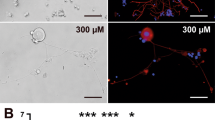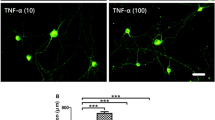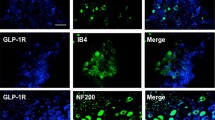Abstract
The purpose of the present study was to investigate whether didanosine (ddI) directly causes morphological and ultrastructural abnormalities of dorsal root ganglion (DRG) neurons in vitro. Dissociated DRG cells and organotypic DRG explants from embryonic 15-day-old Wistar rats were cultured for 3 days and then exposed to ddI (1 μg/ml, 5 μg/ml, 10 μg/ml, and 20 μg/ml) for another 3 days and 6 days, respectively. Neurons cultured continuously in medium served as normal controls. The diameter of the neuronal cell body and neurite length were measured in dissociated DRG cell cultures. Neuronal ultrastructural changes were observed in both culture models. ddI induced dose-dependent decreases in neurite number, length of the longest neurite in each neuron, and total neurite length per neuron in dissociated DRG cell cultures with 3 days treatment. There were no morphological changes seen in organotypic DRG cultures even with longer exposure time (6 days). But ddI induced ultrastructural changes in both culture models. Ultrastructural abnormalities included loss of cristae in mitochondria, clustering of microtubules and neurofilaments, accumulation of glycogen-like granules, and emergence of large dense particles between neurites or microtubules. Lysosome-like large particles emerged inconstantly in neurites. ddI induced a neurite retraction or neurite loss in a dose-dependent manner in dissociated DRG neurons, suggesting that ddI may partially contribute to developing peripheral neuropathy. Cytoskeletal rearrangement and ultrastructural abnormalities caused by ddI in both culture models may have a key role in neurite degeneration.




Similar content being viewed by others
Abbreviations
- AIDS:
-
acquired immunodeficiency syndrome
- BER:
-
base excision repair
- ddC:
-
zalcitabine (dideoxycytidine)
- ddI:
-
didanosine (dideoxyinosine)
- DRG:
-
dorsal root ganglion
- DSP:
-
distal symmetrical polyneuropathy
- HAART:
-
highly active antiretroviral therapy
- HIV:
-
human immunodeficiency virus
- MAP2:
-
microtubule-associated protein 2
- NRTI:
-
nucleoside-analogue reverse transcriptase inhibitor
- TP:
-
triphosphate
References
Berger JR, Nath A. Remedies for HIV-associated peripheral neuropathy. Neurology 2000;54:2037–8.
Brinkman K, ter Hofstede HJ, Burger DM, Smeitink JA, Koopmans PP. Adverse effects of reverse transcriptase inhibitors: mitochondrial toxicity as common pathway. AIDS 1998;12:1735–44.
Brinkman K, Smeitink JA, Romijn JA, Reiss P. Mitochondrial toxicity induced by nucleoside-analogue reverse-transcriptase inhibitors is a key factor in the pathogenesis of antiretroviral-therapy-related lipodystrophy. Lancet 1999;354:1112–5.
Cooley TP, Kunches LM, Saunders CA, Ritter JK, Perkins CJ, McLaren C, et al. Once-daily administration of 2′,3′-dideoxyinosine (ddI) in patients with the acquired immunodeficiency syndrome or AIDS-related complex. Results of a Phase I trial. N Engl J Med 1990;322:1340–5.
Cornblath DR, Hoke A. Recent advances in HIV neuropathy. Curr Opin Neurol 2006;19:446–50.
Cote HC. Possible ways nucleoside analogues can affect mitochondrial DNA content and gene expression during HIV therapy. Antivir Ther 2005;10 Supplement 2: M3–11.
Dalakas M, Semino-Mora C, Leon-Monzon M. Mitochondrial alterations with mitochondrial DNA depletion in the nerves of AIDS patients with peripheral neuropathy induced by 2′,3′-dideoxycytidine (ddC). Lab Invest 2001;81:1537–44.
Ferrari S, Vento S, Monaco S, Cavallaro T, Cainelli F, Rizzuto N, et al. Human immunodeficiency virus-associated peripheral neuropathies. Mayo Clin Proc 2006;81:213–9.
Gilmer WS. Neurologic problems of the lower extremity associated with HIV and AIDS. Clin Podiatr Med Surg 1998;15:281–303.
Hahiguchi K, Bohr VA, de Souza-Pinto NC. Oxidative stress and mitochondrial DNA repair: implications for NRTIs induced DNA damage. Mitochondrion 2004;4:215–22.
Hoschele D. Cell culture models for the investigation of NRTI-induced mitochondrial toxicity. Relevance for the prediction of clinical toxicity. Toxicol In Vitro 2006;20:535–46.
Hulgan T, Hughes M, Sun X, Smeaton LM, Terry E, Robbins GK, et al. Oxidant stress and peripheral neuropathy during antiretroviral therapy: an AIDS clinical trials group study. J Acquir Immune Defic Syndr 2006;42:450–4.
Joseph EK, Chen X, Khasar SG, Levine JD. Novel mechanism of enhanced nociception in a model of AIDS therapy-induced painful peripheral neuropathy in the rat. Pain 2004;107:147–58.
Kallianpur AR, Hulgan T, Canter JA, Ritchie MD, Haines JL, Robbins GK, et al. Hemochromatosis (HFE) gene mutations and peripheral neuropathy during antiretroviral therapy. AIDS 2006;20:1503–13.
Keswani SC, Pardo CA, Cherry CL, Hoke A, McArthur JC. HIV-associated sensory neuropathies. AIDS 2002;16:2105–17.
Keswani SC, Chander B, Hasan C, Griffin JW, McArthur JC, Hoke A. FK506 is neuroprotective in a model of antiretroviral toxic neuropathy. Ann Neurol 2003;53:57–64.
Keswani SC, Leitz GJ, Hoke A. Erythropoietin is neuroprotective in models of HIV sensory neuropathy. Neurosci Lett 2004;371:102–5.
Krambovitis E, Porichis F, Spandidos DA. HIV entry inhibitors: a new generation of antiretroviral drugs. Acta Pharmacol Sin 2005;26:1165–73.
Lambert JS, Seidlin M, Reichman RC, Plank CS, Laverty M, Morse GD, et al. 2′,3′-dideoxyinosine (ddI) in patients with the acquired immunodeficiency syndrome or AIDS-related complex. A phase I trial. N Engl J Med 1990;322:1333–40.
Lee H, Hanes J, Johnson KA. Toxicity of nucleoside analogues used to treat AIDS and the selectivity of the mitochondrial DNA polymerase. Biochemistry 2003;42:14711–9.
Lewis W, Kohler JJ, Hosseini SH, Haase CP, Copeland WC, Bienstock RJ, et al. Antiretroviral nucleosides, deoxynucleotide carrier and mitochondrial DNA: evidence supporting the DNA pol gamma hypothesis. AIDS 2006;20:675–84.
Lopez S, Negredo E, Garrabou G, Puig J, Ruiz L, Sanjurjo E, et al. Longitudinal study on mitochondrial effects of didanosine-tenofovir combination. AIDS Res Hum Retroviruses 2006;22:33–9.
Luciano CA, Pardo CA, McArthur JC. Recent developments in the HIV neuropathies. Curr Opin Neurol 2003;16:403–9.
McArthur JC. HIV dementia: an evolving disease. J Neuroimmunol 2004;157:3–10.
Melli G, Keswani SC, Fischer A, Chen W, Hoke A. Spatially distinct and functionally independent mechanisms of axonal degeneration in a model of HIV-associated sensory neuropathy. Brain 2006;129:1330–8.
Miro O, Lopez S, Cardellach F, Casademont J. Mitochondrial studies in HAART-related lipodystrophy: from experimental hypothesis to clinical findings. Antivir Ther 2005;10 Supplement 2: M73–81.
Moyle G. Clinical manifestations and management of antiretroviral nucleoside analog-related mitochondrial toxicity. Clin Ther 2000;22:911–36.
Moyle G. Mechanisms of HIV and nucleoside reverse transcriptase inhibitor injury to mitochondria. Antivir Ther 2005;10 Supplement 2: M47–52.
Pardo CA, McArthur JC, Griffin JW. HIV neuropathy: insights in the pathology of HIV peripheral nerve disease. J Peripher Nerv Syst 2001;6:21–7.
Petit F, Fromenty B, Owen A, Estaquier J. Mitochondria are sensors for HIV drugs. Trends Pharmacol Sci 2005;26:258–64.
Pettersen JA, Jones G, Worthington C, Krentz HB, Keppler OT, Hoke A, et al. Sensory neuropathy in human immunodeficiency virus/acquired immunodeficiency syndrome patients: protease inhibitor-mediated neurotoxicity. Ann Neurol 2006;59:816–24.
Pinti M, Salomoni P, Cossarizza A. Anti-HIV drugs and the mitochondria. Biochim Biophys Acta 2006;1757:700–7.
Rickert CH, Evers S, Heese C, Reichelt D, Husstedt IW. Immunoglobulin deposition in sural nerves of AIDS patients with distal-symmetric HIV-associated polyneuropathy. Eur J Med Res 2002;7:472–6.
Schifitto G, McDermott MP, McArthur JC, Marder K, Sacktor N, Epstein L, et al. Incidence of and risk factors for HIV-associated distal sensory polyneuropathy. Neurology 2002;58:1764–-8.
Schifitto G, Yiannoutsos CT, Simpson DM, Marra CM, Singer EJ, Kolson DL, et al. A placebo-controlled study of memantine for the treatment of human immunodeficiency virus-associated sensory neuropathy. J Neurovirol 2006;12:328–31.
Simpson DM, Kitch D, Evans SR, McArthur JC, Asmuth DM, Cohen B, et al. HIV neuropathy natural history cohort study: assessment measures and risk factors. Neurology 2006;66:1679–87.
Skopelitis EE, Kokotis PI, Kontos AN, Panayiotakopoulos GD, Konstantinou K, Kordossis T, et al. Distal sensory polyneuropathy in HIV-positive patients in the HAART era: an entity underestimated by clinical examination. Int J STD AIDS 2006;17:467–72.
Verma A. Epidemiology and clinical features of HIV-1 associated neuropathies. J Peripher Nerv Syst 2001;6:8–13.
Wulff EA, Simpson DM. Neuromuscular complications of the human immunodeficiency virus type 1 infection. Semin Neurol 1999;19:157–64.
Wulff EA, Wang AK, Simpson DM. HIV-associated peripheral neuropathy: epidemiology, pathophysiology and treatment. Drugs 2000;59:1251–60.
Yarchoan R, Pluda JM, Thomas RV, Mitsuya H, Brouwers P, Wyvill KM, et al. Long-term toxicity/activity profile of 2′,3′-dideoxyinosine in AIDS or AIDS-related complex. Lancet 1990;336:526–9.
Zhou XJ, Sheiner LB, D’Aquila RT, Hughes MD, Hirsch MS, Fischl MA, et al. Population pharmacokinetics of nevirapine, zidovudine, and didanosine in human immunodeficiency virus-infected patients. The National Institute of Allergy and Infectious Diseases AIDS Clinical Trials Group Protocol 241 Investigators. Antimicrob Agents Chemother 1999;43:121–8.
Acknowledgments
This project is supported by the Foundation for Excellent Young Scientists in Shandong Province of China (No. 02BS091), the Scientific Research Foundation for the Returned Overseas Chinese Scholars, State Education Ministry of China (No. [2003]406), and Foundation for Natural Sciences in Shandong Province of China (No. Z2006C06, Z2006D05)
Author information
Authors and Affiliations
Corresponding author
Rights and permissions
About this article
Cite this article
Liu, H., Liu, Z., Yang, X. et al. Neurotoxicity caused by didanosine on cultured dorsal root ganglion neurons. Cell Biol Toxicol 24, 113–121 (2008). https://doi.org/10.1007/s10565-007-9021-2
Received:
Accepted:
Published:
Issue Date:
DOI: https://doi.org/10.1007/s10565-007-9021-2




